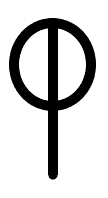DR 110 on:
[Wikipedia]
[Google]
[Amazon]
 DR 110, or the Virring stone, is a
DR 110, or the Virring stone, is a
- entry for Virring-sten. It is tentatively dated to the period 900-960 based on the runes and the language. It had been severely worn down so many runes are missing. A peculiarity in the inscription is the m rune which has a rounded top( ). It also contains an invocation to the
). It also contains an invocation to the
- Rundata entry for SûÑ 111. Old Norse transcription: :ôÏA ''Ge undr(?) ... u gûÎrûƒi minni ƒ¡ ûÎft Sazur. Star resûƒi sten ûÎft dû¡ûƒan. :ôÏB ''ûor wigi ûƒûÎssi kumbl.'' English translation: :ôÏA "Geirmundr(?) ... son made these memorials in memory of Sassurr. Starr raised the stone in memory of the deceased." :ôÏB "May ûû°rr hallow this monument."
Virring-sten at Danske Runeindskrifter
h1>
 DR 110, or the Virring stone, is a
DR 110, or the Virring stone, is a runestone
A runestone is typically a raised stone with a runic inscription, but the term can also be applied to inscriptions on boulders and on bedrock. The tradition began in the 4th century and lasted into the 12th century, but most of the runestones d ...
made of granite
Granite () is a coarse-grained ( phaneritic) intrusive igneous rock composed mostly of quartz, alkali feldspar, and plagioclase. It forms from magma with a high content of silica and alkali metal oxides that slowly cools and solidifies under ...
that measures in height, in width and in thickness. It is written in Old East Norse
Old Norse, Old Nordic, or Old Scandinavian, is a stage of development of North Germanic dialects before their final divergence into separate Nordic languages. Old Norse was spoken by inhabitants of Scandinavia and their overseas settlement ...
in the Younger Futhark
The Younger Futhark, also called Scandinavian runes, is a runic alphabet and a reduced form of the Elder Futhark, with only 16 characters, in use from about the 9th century, after a "transitional period" during the 7th and 8th centuries.
The ...
, and the runestone style is in a form called RAK.
It was discovered in 1865 being used as the threshold for the church porch in the church of Virring in Denmark.Danske Runeindskrifter- entry for Virring-sten. It is tentatively dated to the period 900-960 based on the runes and the language. It had been severely worn down so many runes are missing. A peculiarity in the inscription is the m rune which has a rounded top(
 ). It also contains an invocation to the
). It also contains an invocation to the Norse god
In Germanic paganism, the indigenous religion of the ancient Germanic peoples who inhabited Germanic Europe, there were a number of different gods and goddesses. Germanic deities are attested from numerous sources, including works of literature ...
Thor
Thor (; from non, ûû°rr ) is a prominent god in Germanic paganism. In Norse mythology, he is a hammer-wielding god associated with lightning, thunder, storms, sacred groves and trees, strength, the protection of humankind, hallowing, an ...
(''ûor wigi ûƒûÎssi kumbl''), which it shares with a number of other runestones in Sweden and Denmark
)
, song = ( en, "King Christian stood by the lofty mast")
, song_type = National and royal anthem
, image_map = EU-Denmark.svg
, map_caption =
, subdivision_type = Sovereign state
, subdivision_name = Kingdom of Denmark
, establish ...
: the RûÑk runestone
The RûÑk runestone ( sv, RûÑkstenen; ûg 136) is one of the most famous runestones, featuring the longest known runic inscription in stone. It can now be seen beside the church in RûÑk, ûdeshûÑg Municipality, ûstergûÑtland, Sweden. It is co ...
(''ûérr''), the Velanda Runestone
The Velanda Runestone ( sv, Velandastenen), designated as Vg 150 in the Rundata catalog, is a runestone dated to the late tenth century or the early eleventh century that is located in the village of Velanda, TrollhûÊttan Municipality, VûÊstra ...
(''ûorr vigi''), Glavendrup stone (''ûor wigi ûƒûÎssi runaò''), Sû¡nder Kirkeby Runestone
The Sû¡nder Kirkeby Runestone, listed as runic inscription DR 220 in the Rundata catalog, is a Viking Age memorial runestone that was discovered in Sû¡nder Kirkeby, which is located about 5 kilometers east of Nykû¡bing Falster, Denmark.
Descripti ...
(''ûor wigi runaò'') and possibly SûÑ 140 (''Siû¯i(?) ûorr(?)'').
Inscription
Below follows a presentation of the runestones based on the Rundata project. The transcriptions into Old Norse are in the Swedish and Danish dialect to facilitate comparison with the inscriptions, while the English translation provided by Rundata gives the names in the de facto standard dialect (the Icelandic and Norwegian dialect): Latin transliteration: :ôÏA ûñ ki-mutr ûñ ôÑ ... ...n ûñ k(a)rûƒi ôÑ ûñ m(i)n(i) ûñ --(u) ûñ af(t) (ûñ) ôÑ ûñ sasur ûñ star ôÑ r(i)sûƒi ûñ stin ûñ aft ûñ tuûƒan ûñ :ôÏB ûƒur ûñ uiki ûñ ûƒisi ûñ kuml ûñProject Samnordisk Runtextdatabas Svensk- Rundata entry for SûÑ 111. Old Norse transcription: :ôÏA ''Ge undr(?) ... u gûÎrûƒi minni ƒ¡ ûÎft Sazur. Star resûƒi sten ûÎft dû¡ûƒan. :ôÏB ''ûor wigi ûƒûÎssi kumbl.'' English translation: :ôÏA "Geirmundr(?) ... son made these memorials in memory of Sassurr. Starr raised the stone in memory of the deceased." :ôÏB "May ûû°rr hallow this monument."
Sources
* RundataVirring-sten at Danske Runeindskrifter
h1>
References
{{runestones Runestones in Denmark 10th-century inscriptions